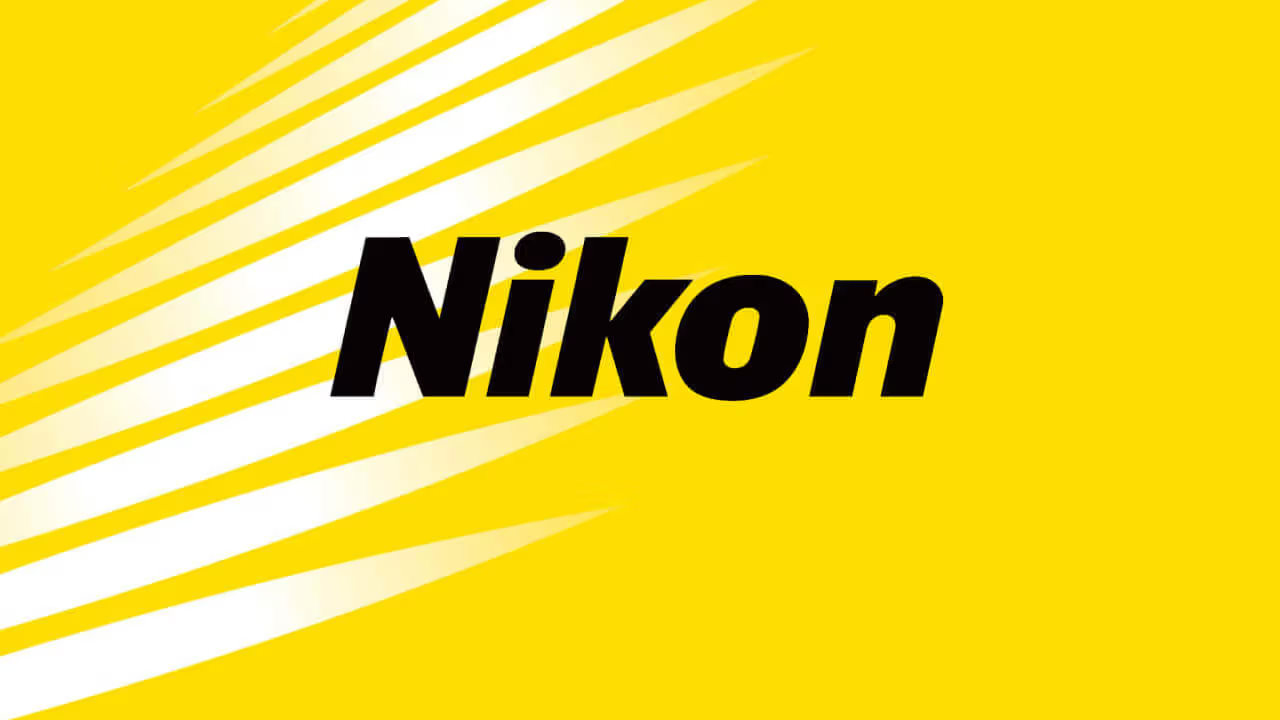Nikon is a Japanese multinational corporation that specializes in optics and imaging products.
From cameras and microscopes, to optical measurement systems, Nikon offers a large variety of products to its customers, which are renowned for their outstanding optics, design, and features
Interesting Statistics of 2021 Highlighting Nikon’s Growth:
- Revenue of $4.4 billion
- Operating profit of $0.4 billion
- Market capitalization of $3.77 billion
- Stock price of $10.6 on 31st March, 2022
- Total assets of $8.5 billion
- Workforce of 18,400 employees
- Market share of 33.9% for DSLR cameras
- Operations in 70 countries
While Nikon has been struggling to stay afloat as new competitors emerge in the market, most loyal customers can’t imagine a world without Nikon’s cameras.
Let's take a deeper look at Nikon's remarkable innovations right from its foundation in 1917 to today - more than a century later.
Nikon’s Beginning and Launch Of First Products
Nikon—previously named “Nippon Kogaku”—was established in 1917 in Tokyo.
In the early 20th century, Japan was striving to modernize itself and establish its place in the global market. As a result, developing different domestic products was the country’s top priority.
Nikon Begins with a Merger
The production of advanced optical instruments was a “matter of national urgency” and thus, the president of an already well-established brand, Mitsubishi, was entrusted with this tremendous task. His name was Koyata Iwasaki.
The easiest way to establish an optics company was to build on the expertise of preexisting companies.
With that logic, Iwasaki merged the optical instruments division of the Tokyo Keiki company and the mirror division of Iwaki Glass with Fujii Lens Manufacturing.
By bringing together the expertise of each of these divisions, Iwasaki was able to get a headstart in the domain of optical manufacturing.
What Were Nikon’s First Products?
In 1918, Nikon started its research on optical glass but reached a dead end.
Despite the joint expertise, the company could not initially address the myriad technical difficulties that came with manufacturing the product.
The research on optical glass was suspended temporarily, and the company worked on developing its binocular models.
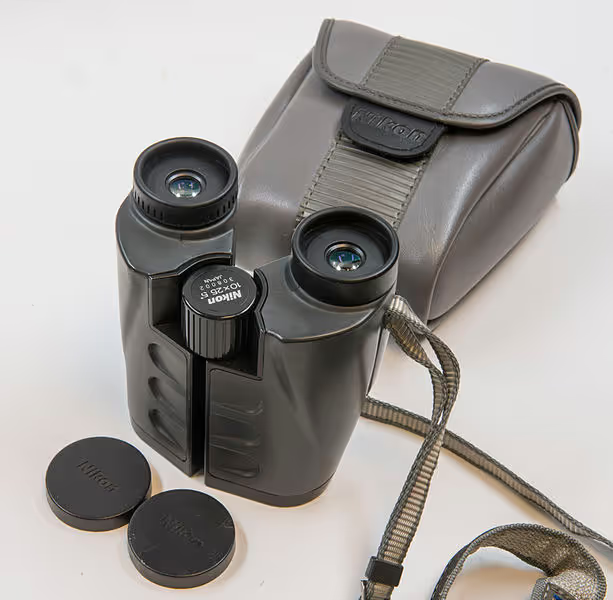
In 1921, the MIKRON ultra-small-prism binoculars were designed, manufactured, and sold by Nikon. With their compactness and high functionality, they became leading products in the market, and updated versions of the product continue to reign to this day.
On the other hand, Nikon's strategy included importing technical knowledge from foreign industries.
In 1921, the company invited eight engineers from Germany who would initiate the design of Nikon’s photographic lenses.
To step into the optical market, the company needed to fully encompass the competitors' technologies. It first started by imitating European products before adding its own twist to them and, therefore, rendering them unrecognizable from their European counterparts.
The first series of lenses, which were more or fewer copies of European lenses, were called “Anytar.” This lens was designed by Heinrich Acht, one of the eight engineers invited to Japan.
In 1929, after Acht departed from Japan, the company made improvements to the lens.
In the meantime, the need to produce optical glasses became more pressing, and in 1922, the company resumed its suspended research.
It started by creating research facilities, and sure enough, in a matter of months, Nikon had carried out its first test-melting of glass and performed it's first kilning—both of which are important stages of the production of optical glass.
However, tragedy came in the form of the Great Kanto Earthquake, which damaged the company's glass research facilities.
In under five months, Nikon recovered the damage, and the research was then resumed. By March of 1927, 70 major melts and 220 trial melts had taken place. These efforts would improve the company's glass quality while creating the foundation for mass production.
The company also set up an analysis laboratory in its Oi Dai-ni plant and began research into other stages of optical glass production, such as glass annealing. In 1927, Nikon achieved its first successful glass annealing.
Nikon’s First Microscope Sets The Foundation
Along with the mass production of optical glass; the company had also been working on developing a microscope since day one. Its efforts came to fruition in 1925, with the release of its very first microscope.
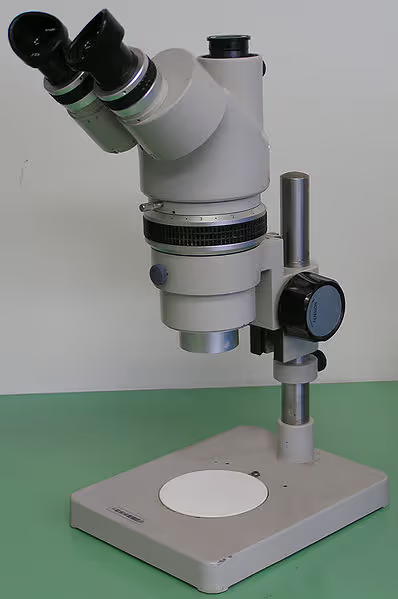
The same engineer who created the Anytar lens was involved in the development of this product, as he brought with him rich expertise in the domain.
Together with Acht, Nikon released its JOICO microscope in 1925. With its 765x magnification, the microscope was a big deal at the time.
Here Come The NIKKOR Lenses
Developing photographic lenses isn't easy, but Nikon achieved that feat in 1929 when it released its first camera lens called the "Anytar 12cm F4.5.”
The lens was the first in a series of camera lenses, which would collectively be known as the NIKKOR lenses.
These were born out of a strong desire of the Japanese to break out of their dependency on European companies for photographic lenses.
Nikon’s business model revolved around learning from experts in the field. Local designers traveled to Europe, visiting camera store after camera store in Berlin, until they had some semblance of an understanding of the production of these lenses.
Even then, the process was tedious, and quite often, the image quality would not come out as wonderful as expected.
After much trial and error, however, the company was successful in developing the lenses.
The product name "NIKKOR lenses" was designated in 1933 when the company delivered lenses that could be used in aerial photography. These would come in handy for map-makers.
These lenses, introduced in 1933, were titled “Aero-NIKKOR.”
Nikon’s Product Reaches the Tokyo Science Museum
In 1931, Nikon’s 8-inch astronomical telescope was installed in the roof observatory dome of the Tokyo Science Museum (which is now called the National Museum of Nature and Science).
It was the first full-fledged model of its kind produced in Japan.
The telescope stayed in the museum for about seventy years. During this period, it underwent many modifications, as developers kept it up to date. Its superiority made it the perfect instrument to take a look into the heavens.
The telescope still exists and is on permanent display in the same museum, in a zone called “Exploring the Universe.”
Key Takeaway #1: Lead Your Industry by Incorporating Diverse Practices
The designers of Nikon didn’t shy away from learning from their European colleagues. In fact, the company even brought in eight German engineers to aid their local engineers in the development of the lenses.
Where the German engineers could not help, Nikon’s designers took it upon themselves to visit Germany and learn through observation and inquiry, the tedious process of photographic lens production.
These ‘lessons’ in manufacturing paid off, and it wasn’t long before Nikon became a leading name in the production of optical lenses in Japan.
Nikon’s Innovation During Mid-20th Century
Over the next few decades, the Nikon brand exploded in the global photography market as it reached milestone after milestone.
This was achieved through a mix of high-end products and clever marketing strategies, which would seal its name as a leading business all over the world.
Nikon set off the process of expansion by first going public in 1939.
The First Nikon Camera
In 1946, the company's breakthrough came in the form of its new compact cameras. It was anticipated that these cameras would be popular in the market, so the leaders wanted to give the cameras a powerful brand name.
At that point, the company was still called "Nippon Kogaku." Initially, Nikon settled for the brand name "Nikko" which was an abbreviation of its original name. Afterward, they added an "n" to the name, birthing the new company name "Nikon."
The first Nikon camera was sold and marketed in 1948. It was initially called “Nikon” but as the company developers introduced new models, “Model I” was added to its name.

In the same year, the Model I profile projector was also introduced, which offered new features such as the parallel beam illumination method.
The expectations regarding the camera were met when in 1950, the New York Times published an article lauding the quality of the Nikon cameras and the NIKKOR photographic lenses.
The praise came following high acclaim from LIFE magazine photographers who had traveled to the Korean War battlefields armed with Nikon’s cameras.
While other cameras had been unable to withstand the freezing temperatures of the Korean Peninsula, the Nikon cameras were able to produce high-quality pictures, documenting the bloodshed of the war.
The article was a huge accomplishment for the company as it hailed the company's cameras as one of the best in the world and even “better than German lenses.” Plus, it contributed to Nikon’s sales growth in the following years.
The accomplishment was also monumental on a national level, as it was the first time Japanese cameras had performed so well. Previously, cameras from the country had been known only for their beautiful exteriors.
The “Made in Japan” stamp was renewed; instead of being associated with bad quality, the stamp now became a marker of excellent performance.
The NIKKOR Lenses - A Symbol of Optical Perfection
Another breakthrough for the company came in the form of an extremely high-resolution lens released in 1962.
After World War II, Nikon relied on microfilm cameras imported from the USA. Before the printing press existed, microfilm cameras were used to store documents.
However, the catch was that English characters were easier to capture than the intricate Japanese alphabet. The company catered to this local demand by introducing high-resolution lenses called "Micro NIKKOR" in 1956.
Demand for resolution increased even further over time as companies needed high-resolution lenses to create printed circuit boards.
In the August of 1962, Nikon was finally able to meet this demand after much difficulty in the form of the “Ultra Micro-NIKKOR.” Only two years later, the company updated the product, effectively developing a lens with the highest resolution in the world.
For reference, in 1964, Nikon’s innovative lenses were able to distinguish 1260 paired black and white strips per millimeter.
The lenses took the global and domestic markets by storm. They were also used later as the core technology of lithography systems, which would be called “the most precise machinery in the world.”
How Did Nikon Cameras Evolve Overtime?
From the moon to the North Pole, Nikon’s cameras reached all sorts of peculiar places in the years to come.
This was largely because Nikon's engineers took specific requests from organizations and celebrities and focused on updating the cameras as rapidly as possible.
In 1959, the company released the Nikon F camera, which would become an important milestone in Nikon’s history.
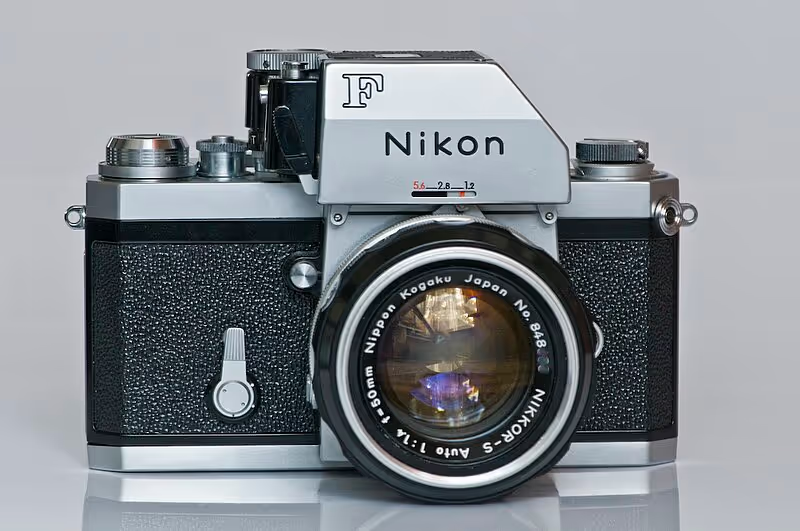
This camera brought together Nikon’s optical and precision technology and garnered a major reaction across the globe.
It became the company’s first lens-interchangeable camera and was renowned all over the world as a high-end SLR. It remained in production for 15 years, with more than 800,000 units produced!
Over the years, many more models of the Nikon cameras were introduced, each contributing additional features and catering to specific demands. These features were one of the biggest reasons for Nikon’s success.
For example, the NIKONOS all-weather camera was introduced in 1963. As the name suggests, this camera was resistant to all weather and could withstand water/air pressure as well as heat.
In 1971, a Nikon camera landed on the moon.
NASA had made special requests to the company to create a camera that would overcome the extreme environments of space. As a result, Nikon launched the Nikon Photomic FTN, which made use of NASA-specified materials such as lubricating oil.
The Nikon F2, on the other hand, was created for the professional photographer as well as the novice, as the camera offered easier operation, faster shooting, and impeccable quality all in one product.
In 1977, a Nikon camera made it to another peculiar place: the North Pole.
After Naomi Uemura, one of Japan’s leading adventurers, first discovered the Nikon cameras when he first completed his dog sled trip around the Arctic Circle in 1976. Almost all of the photographers who greeted him at the finish line were armed with Nikon cameras.
As a result, Uemura requested the company to create a special camera for him, which he would use on his trip to the North Pole.
Nikon’s engineers immediately set to work and, after some experimentation, created the world’s first titanium-exterior SLR camera in 1977.
This camera was called the Nikon F2 Titanium Uemura Special, named after the famous adventurer. In 1978, Uemura used the camera to document his six-month adventure to the North Pole.
Nikon’s Marketing Strategy: Organize Photography Clubs and Contests
For Nikon, simply developing high-end products wasn’t enough. As the years passed, the company came up with new marketing strategies to promote photography culture.
The NIKKOR club was founded in 1952 with the help of renowned Japanese photographers like Ihei Kimura, Ken Domon, Jun Miki, Yusaku Kamekura, Kenji Mizoguchi, and Hideko Takamine.
These photographers were not just experts in the field, but they were also passionate about promoting photography culture. For example, in 1950, Kimura and Domon had set up a photographers’ society in Japan.
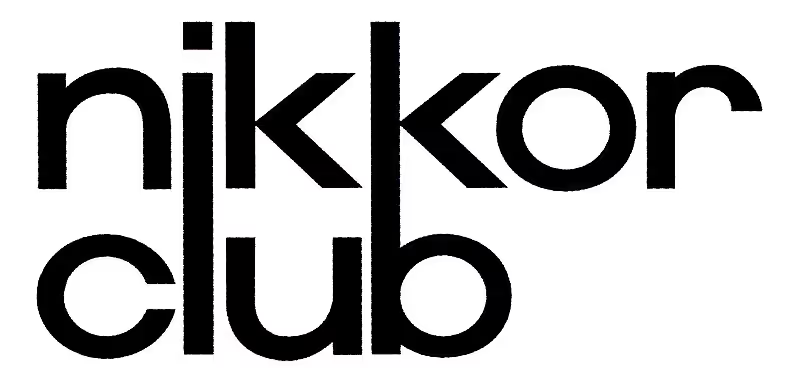
Their expertise and passion helped the Nikkor Club grow. In 1953, the Club released its first newsletters, which were widely read by its audience.
Over the years, the Club continued to serve as a marketing platform for the company, boosting Nikon's market share. One of the most prominent events arranged by the Club was the Nikkor Club Tokyo Grand Photo Session.
In 1968, more than 6000 Nikon fans gathered at the Hayama Marina for the photo session. The event was divided into exciting segments, from photography instruction sessions to model photo shoots.
The event helped bring together professionals and fans and garnered interest in photography, as well as Nikon's cameras and photographic lenses.
Similarly, the company also opened a photo gallery called the Ginza Nikon Salon. The first exhibition of this gallery was called "The Eyes of Ihei Kimura” – who was a celebrated Japanese photographer.
Another marketing strategy adopted by Nikon was arranging a photography contest sponsored by the company. This contest was titled “1st Nikon Photo Contest International.”
In its first year, 1969, the contest attracted more than 21,000 submissions from thirty-seven countries all over the world. The contest proved to be a massive success in terms of attracting the relevant audience.
Nikon continues to hold an annual photography contest to this day. It is now known as the “Nikon Photo Contest.”
Furthermore, since 1974, the company has chosen the Nikon Calendar photos from contest submissions, allowing participants to reach out to large audiences while promoting their own products.
Key Takeaway #2: Nurture a Community Around Your Product
Nikon’s marketing strategy was not limited to airing simple advertisements. Its establishment of the photography club and the photo contest promoted the culture of taking pictures all over the world.
Events like the Grand Tokyo photography session further created a sense of community around the Nikon cameras and motivated people to engage in the art of photography.
As a result, the company was able to create a newfound desire for its product—not just by developing high-quality products but by creating avenues through which the products could be put to good use.
Nikon’s Expansion of Product Range
Following the success of its cameras, the company continued to update its Nikon series and introduce new products along the way.
The Nikon strategy was to bank on opportunities if a new need arose in the market. Whether it was film cameras or high-precision lenses, the company's engineers were the first to produce them.
Nikon: A History of Firsts
In 1976, the VLSI Technology Research Association asked Nikon to develop a stepper, which would reduce circuit pattern sizes by 90%.
The development of the stepper required the company to master several core technologies.
Firstly, the stepper required a projection lens capable of high-precision resolution and a high-precision, high-speed moving stage for positioning. The issue with the moving stage was that it was difficult to get it to move straight.
Nikon beat the obstacle and emerged victorious, creating a device that was accurate enough to “hit a tennis ball with an arrow on the top of Mount Fuji all the way from Tokyo.”
For reference, Mount Fuji is on the island of Honshu, which is 62 miles away from Tokyo.
Secondly, the stepper also required photo-electric sensors, which would convert light into electric signals. Nikon's innovation and expertise shined through in this phase of production as well.
Within two years, the company delivered the first prototype of the product and received high acclaim. Later, in 1980, the NSR-1010G stepper was introduced, becoming the first domestically produced commercial device.
In the next year, Nikon released the TITEX titanium ophthalmic frame, once again being the first in the world to develop such a unique product. These frames were stronger but lighter, making them a useful option for anyone looking for a more comfortable experience with glasses.
Nikon scored another first in 1984 when it introduced the NT-1000 35mm film direct telephoto transmitter. This was developed together with Kyodo News Agency and specifically designed for use by the media.
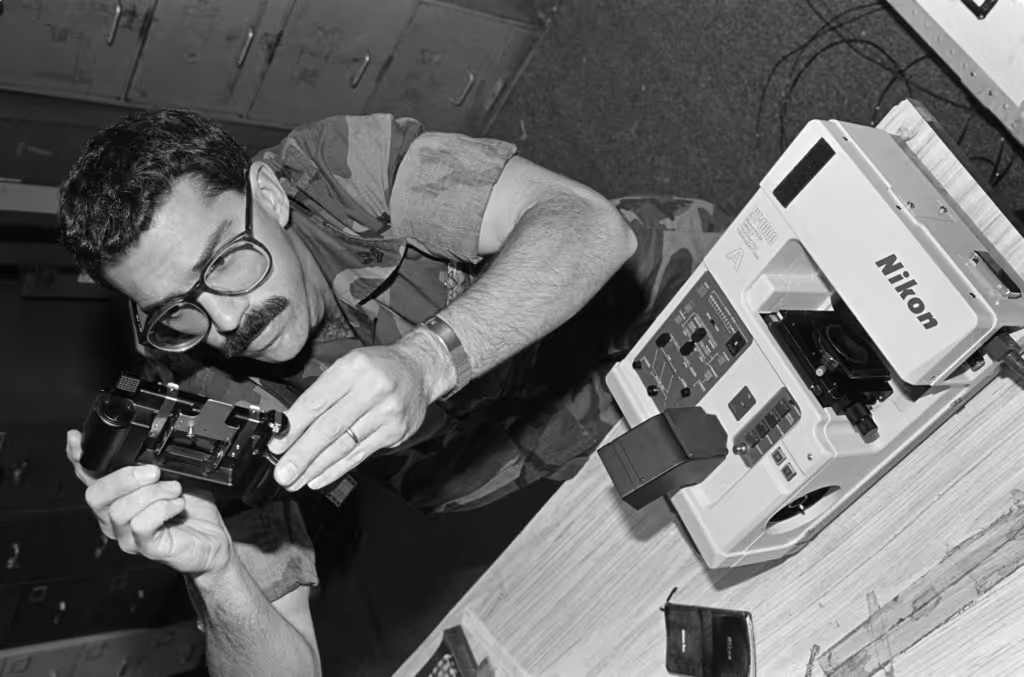
The device revolutionized traditional systems by allowing users to read photographic negatives and positives directly. Previous systems made use of enlarged prints.
Since direct reading was quicker than enlarging prints and reading them, the device was perfect for the time-sensitive needs of journalists.
Along with this telephoto transmitter, the company released a still video camera system in 1988, both of which ultimately paved the way for digital camera systems in the future.
In 1985, the company released its first digitized surveying instrument, and in 1986, Nikon further diversified by developing the TRISTATION 600 and 600M three-dimensional coordinate measuring machines. With these, Nikon hit another first, as no such machine in Japan achieved such spatial accuracy as these did.
The following year, Nikon released the NSR-L7501G large substrate exposure system, which was the first of its LCD steppers and scanners. Once again, the product was unique in the market, as it could expose a maximum area of 75mm compared to the 30mm area in the traditional lithography world.
A few years later, in 1995, Nikon came up with another revolutionary invention: the CNC video measuring system.
As technology progressed, there was a pressing need to produce extra-precise measurements of electronic and automotive parts without touching them.
The CNC video measuring system was the solution to this issue: the system combined image-processing technologies and optical measurement technologies to produce a non-contact measurement system.
The company made another breakthrough in 2006 with the release of its ArF immersion scanner. This first of its kind, this product changed the direction of immersion lithography technology and achieved the world’s highest N.A.
N.A. controls the quality of the image produced through lithography. This means in 2006, Nikon was producing the best-quality images out there!
The company didn’t stop with the measuring system. Nikon’s strategy has always been to release product after product that would blow away customers from different markets.
The next year, the company came up with the groundbreaking BioStation CT cell culture observation system, which would help in live-cell observation.
What this device did was, it inserted the microscope inside the incubator. This meant that scientists didn’t have to remove live cells to observe them.
Another development came in 2010 when Nikon marketed its new non-contact multi-sensor 3D metrology system. While the measurement system that the company created in 1995 was already way ahead of its time, this system jumped further into the future with its on-the-mark measurements and high speed.
While the company has been known mostly for producing cameras, all the aforementioned products shed light on its indispensable position in the optical market, boosting Nikon's market share in other areas as well.
How did Nikon Develop its Cameras in the Late 20th Century?
Nikon's innovation saw no end when it came to camera creation. The company put out model after model as its engineers hunched over tables, determined to provide the best image quality in the world.
A few of these were of particular importance.
For example, in 1980, the Nikon F3 was developed, which was the first camera to offer electronic shutter control.
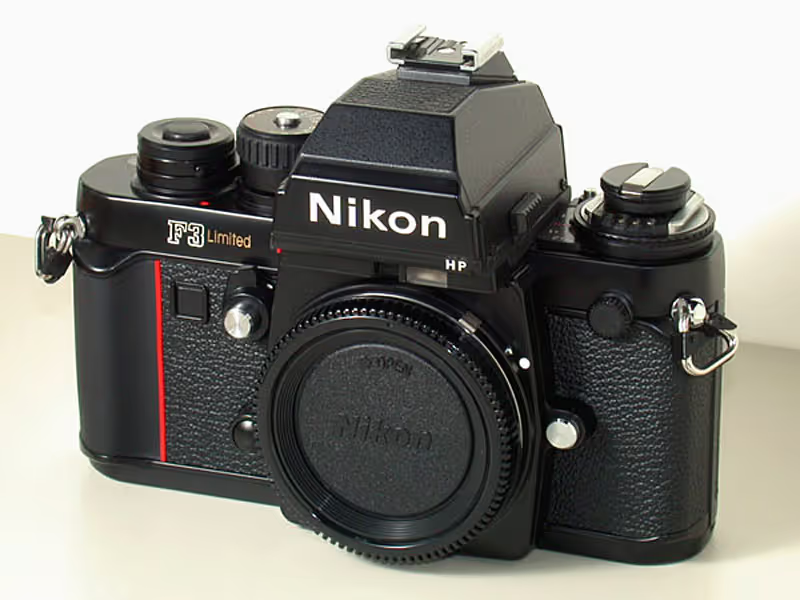
In the same year, the Nikon F3 Big Camera was developed, along with an F3 Small Camera, both of which traveled to space in 1981. These cameras were made at NASA's request.
In 1983, the company released an SLR camera with an AF mechanism. While today the auto-focus feature in cameras seems common, back in the day it was a challenge to achieve this feat.
A few years later, Nikon decided that its cameras should also travel underwater. 1992 saw that decision come to fruition with the release of the Nikonos RS underwater AF SLR camera—yes, the AF means, the auto-focus function was present even underwater!
In 1995, the company collaborated successfully with Fuji Photo Film Co., Ltd. and released its E2 and E2s cameras. The expertise of Fuji Film came to much use, as digital cameras would become omnipresent in the future.
Two years later, Nikon would come up with its first compact digital camera on its own.
During that time, the company was working on another project—developing the well-known DSLR camera. This camera was released in 1999 and was revolutionary in various aspects including quality, speed, dimensions, and price.
The DSLR was developed in just two short years and stood out in the market for being just one-third of the price of its competitors.
In 2010, new models of the digital SLR cameras, D3S and D3X found themselves in NASA’s space station. The International Space Station continues to use them for internal and extravehicular activities.
Key Takeaway #3: Grab Untapped Opportunities by Applying Your Expertise to Different Industries
Nikon could have stopped at the production of cameras—they were hugely successful either way—but the company grew because it diversified and targeted other markets as well.
For example, Nikon produced microscopes that allowed for live-cell observations. This was a unique problem faced by biologists. The company had done its research; it knew of the gap in the market and it rushed in to fill the space.
Similarly, the optical measurement systems created by Nikon weren’t targeted at photographers, but at automotive markets.
These systems would allow automotive—and other electronic—markets to come up with precise measurements for the parts of their machines.
Nikon understood that the use of lenses was not limited to producing images, but that they could also be used to come up with measurements. Their in-depth knowledge of their product allowed them to venture into previously untapped markets and generate high revenues through them.
Nikon’s diversification would also be the reason why it would stay afloat in the following years.
Nikon’s Digital Transformation and Fight Against Competitors
Despite Nikon’s innovative products, the company faced a turbulent period in 2013 with the rise of smartphones.
The company was only able to stay afloat because of the various other products it had sold.
When profit dropped by about 50% in 2013, however, the company decided to focus more on said products, while exploring other optical technologies tentatively.
How did Nikon Beat the Smartphones?
Stripped off its demand for digital cameras, Nikon made a smart decision to set aside money for deals, mergers, and acquisitions.
The best way to deal with the crisis, after all, was to turn to companies that were doing different things and learn from them.
In 2015, the company took over U.K.’s Optos Plc., which was a medical technology company. This acquisition was true to Nikon's earlier decision to focus on products other than cameras and would allow the company to tap into a new market.
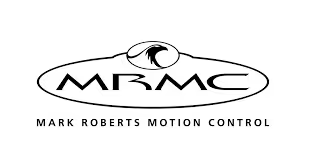
Nikon also soon gained 100% control over Mark Roberts Motion Control Ltd. This company specialized in motion control equipment used in films and advertisements.
Once again, the takeover filled in some of the gap left by the reduced digital-camera demand as it focused on a separate market. After all, smartphones were well and good when it came to individual usage, but films and advertisements required more high-quality equipment.
A few years later, in 2019, Nikon took another initiative by establishing the Next Generation Project Division. This division is aimed at providing manufacturing solutions to clients to create greater synergy in the optical industry. The project also intended to form strategic investments and alliances with industry-leading companies worldwide.
This was a step away from Nikon’s traditional develop-and-sell strategy over the years.
Two years later, Nikon established a stronger foothold over the market by acquiring yet another company—Morf3D. In line with its new project division, this company also provided additive manufacturing solutions to clients.
Nikon’s Marketing Strategy: The Nikon Museum and “Capture Tomorrow” Campaign
As Nikon hit its first century, the Nikon Museum was opened to set off its 100th birthday celebration.
This was a unique marketing strategy, as the company’s entire history was put on display in the museum. A shop was also set up within museum grounds to encourage visitors to buy Nikon’s products.
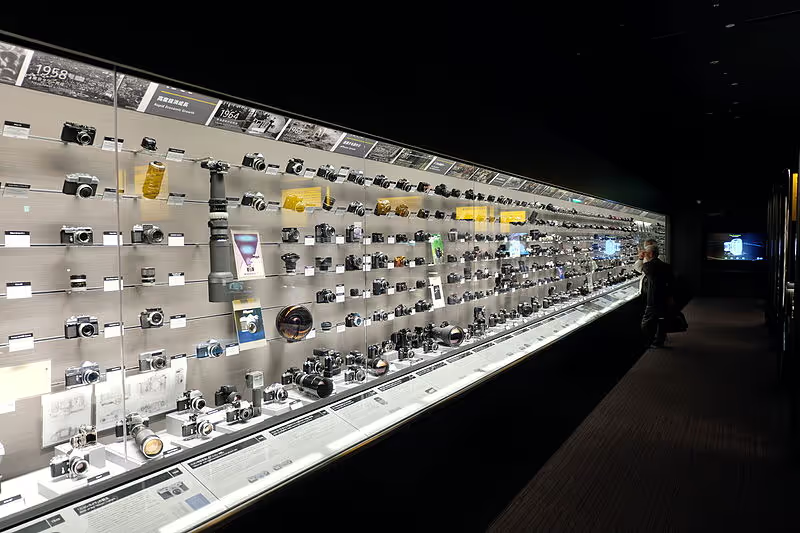
Just like the NIKKOR club became a marketing platform, the museum, too, served the same purpose.
The museum would intermittently hold screenings of movies like “The F2, the World’s Greatest Mechanical Camera” or “The Appeal of the NIKKOR”, which would create awe around the company’s products and give them higher exposure.
Nikon merchandise was also available at the museum (there were mugs with camera illustrations!). In short, the company aimed to form a sense of community around its products through its museum.
Nikon’s marketing strategy was more robust than ever. The company also established a BioImaging Lab, which would attract relevant customers from a more niche market.
This research lab was aimed at scientists looking for high-quality optical equipment to carry out their research and was an excellent way of bringing them together organically, while subtly providing their products within lab grounds.
Lastly, the company also launched the “Capture Tomorrow” campaign with the help of world-famous photographers such as Jamari Lior and Weerapong Chaipuck.
The campaign aimed to pivot Nikon toward a “future-oriented outlook”. It consisted of shots taken by the aforementioned photographers through its new Z series mirrorless cameras. These shots, along with a video, were revealed to the public.
According to Stephanie Dugas, the campaign focused “on the brand’s energy in driving excellence and reshaping the future of photography to explore limitless possibilities.”
How Did Nikon Embrace Digital Transformation?
Over the last decade, Nikon released many more products, including updated versions of cameras, microscopes, and telescopes.
Smooth operations of the company could not have been possible without internal digital transformation.
Over the past decade, the company has bought software like Salesforce Service Cloud, SAP Cash Management, and Adobe Connect, to ensure the efficient organization of the business.
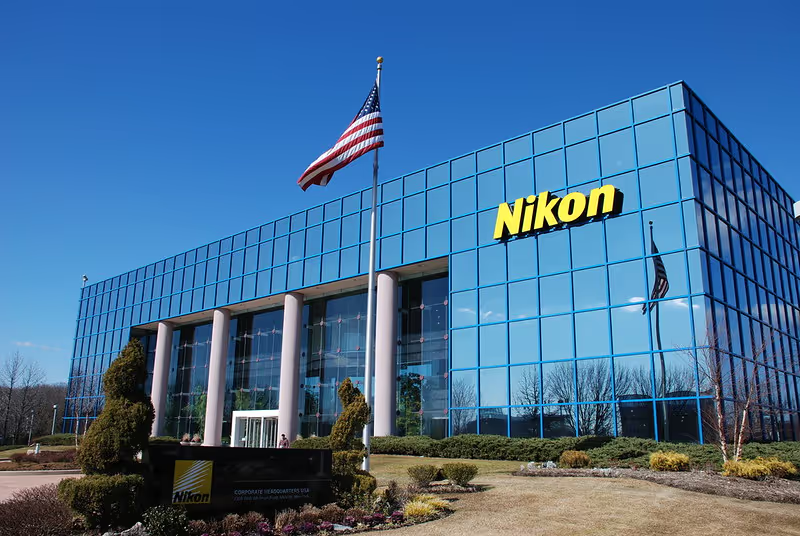
Nikon also signed an agreement with Digizuite, aiming to use its Digital Asset Management (DAM) SaaS software as part of its digital transformation strategy.
The software would allow consistent distribution of the brand’s digital content. This was important to achieve as the company was also conducting operations in Europe as well as Japan.
Since Nikon is a technological company, its research centers are well-equipped and conducive to innovation and invention as well.
Key Takeaway #4: Reframe Your Solution to Create a New Market and Increase Demand
Nikon faced a backlash because of its focus on cameras but thankfully, it had other products to keep its ship sailing.
One of the things that Nikon did while responding to the declining demand for its digital cameras was to engage in takeovers and acquisitions that would boost products that were still in high demand.
This allowed the company to compensate for its losses in the camera market.
On the other hand, Nikon didn’t give up on cameras. By adopting a marketing strategy that focused on promoting photography culture, the company was able to bring back some of its revenue from the camera market.
In contrast with smartphones being the new “in” product, Nikon created a brand image that made it seem like a “future-oriented company”. For example, its new tagline read “Unlock the future with the power of light”. It also created multiple social media accounts–especially on Instagram–to interact with the youth and promote photography culture among them.
In that sense, Nikon pushed back against the smartphone revolution, putting its cameras as the face of the future.
In other words, Nikon tried to ensure that its cameras were the “right products”. After all, it couldn’t waste years of investment on its high-quality cameras.
It is important to remember that it was able to do so because the demand for cameras hadn’t completely disappeared. Professionals still needed cameras for their photography. What Nikon needed to do was create more professionals by promoting photography culture.
Why Is Nikon So Successful?
Nikon’s continuous innovation and smart marketing strategies made it a leading optical company in the global market.
Nikon’s Vision
Nikon strives to brighten the human experience through its cameras.
“Unleashing the limitless possibilities of light. Striving to brighten the human experience. Focused, with purpose, on a better future for all.”
Nikon’s Mission
Nikon’s mission is to empower people through its imaging products.
“To know what you want from imaging today and tomorrow, and to empower you through images to realize your dreams.”
Nikon’s Growth by Numbers
Strategies to Learn from Nikon’s Journey
Nikon’s journey offers many lessons for business leaders, c-level executives, and entrepreneurs hoping to make an impact.
Some of the key strategic takeaways are as follows:
- Learn from Competitors to Beat them
During its initial years, Nikon had to depend upon German engineers to help develop its first products.
For example, its Anytar lens was created with the help of Heinrich Acht, who was one of the eight foreign engineers invited to Japan.
When the engineers left, Nikon had an abundant pool of knowledge and expertise to draw from.
Only a few decades later, the company surpassed its German competitors, when the New York Times hailed its lenses as far better than their German counterparts, boosting Nikon’s market share internationally.
- Establish Your Market Presence Through Memorable Events
Nikon had an annual photo contest that reminded both fans and potential customers of its presence in the world each year.
Similarly, the company also held events such as Tokyo Grand Photo Session, which brought traffic their way.
It helped that the people who organized these events were often experts solicited by the company.
By gathering experts and holding such events, Nikon was able to create a tradition around its cameras. Plus, there was an increasing sense of community as professionals and amateurs came together in the NIKKOR club to learn the art of photography.
- Be the First to Create Solutions to Customer Problems
Nikon’s strategy revolved around being the “first” to figure out potential customers who were facing imaging-related problems. Due to this attitude, the company was able to develop solutions to problems faced by a diverse audience, including scientists and astronauts.
Nikon was also quick to identify the unique needs created by the technological revolution. By developing and marketing an accurate optical measurement system, the company was able to generate revenue from all those manufacturers who needed precise measurements for their products’ electronic parts.
On the other hand, the company created new possibilities—by introducing waterproof and space-weather conducive cameras, Nikon allowed customers to take their products to places they would never have imagined before.
- Concentrate on Products with the Highest Revenue Turnover
When smartphones surpassed digital cameras in the market, Nikon realized that it could no longer invest most of its energy in cameras.
It shifted its attention to other products in that duration. For example, it was in the last decade that the company established a bioimaging lab, which would boost the sales of its microscopes.
The company also acquired relevant companies such as Optos Plc which would allow it to gain expertise in the medical technology market.
It was important for the company leaders to recognize that if they didn’t turn their attention to other products, their revenues would fall. In the end, Nikon’s diversification strategy boosted its revenue growth.
It is worthwhile to note that Nikon didn’t try to compete against hegemonic trends; it tried to align itself with those trends and provide solutions to different potential audiences.
Nikon’s journey has not been easy but it has managed to stay afloat for over a century. The key to its success has been its innovation of products, as well as its unique ability to rapidly offer solutions to emerging problems in the market. While the company has found itself in deep waters due to competition, it still enjoys a high market share and is indispensable in the optical imaging market.


